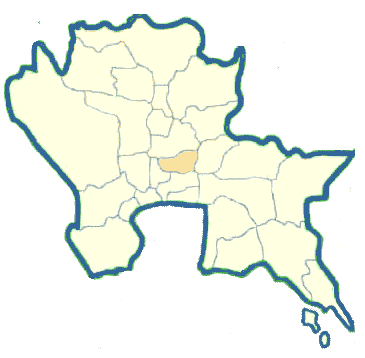Pathum Thani Province in Central Thailand

The original name of Changwat Pathum Thani is Muang Sam Khok which was founded during the Ayutthaya era. It was a settlement for Mon People migrating from Mohtama during the reigns of King Prasat Thong and King Narai the Great. During the reign of King Taksin there were some additional Mon families who moved to Ban Sam Khok which is now located in Amphoe Sam Khok. In 1815, when King Phra Phuttha Lertla made a royal visit to Muang Sam Khok, a lot of the inhabitants of Sam Khok offered him lotus flowers. He then gave to Sam Khok, the new name of Pathum Thani. Later on, the spelling was changed to be Pathum Thani. This was during the reign of King Vajiravudh when he came to preside at the inauguration of the Provincial Administrative building (Sala Klang).
Pathum Thani is only 46 kilometers from Bangkok, conveniently accessible both by land and water. It occupies a total area of 1,565 square kilometers and is administratively divided into seven Amphoes: Muang, Lat Lum Kaeo, Sam Khok, Thanyaburi, Nong Sua, Khlong Luang, and Lam Luk Ka.
What to see and what to do in Pathum Thani?
City Pillar Shrine, located in the compound of Sala Klang, was constructed on January 3,1977. Having a four-gabled design to house the city pillar, it is similar to a lotus stem and a statue of the Narai God. On one side is enshrined a Buddha image of Sukhothai style in the attitude of Subduing Evil.
Wat Chinwararam is located on the west bank of the Chao Phraya River opposite the mouth of Khlong Rangsit Prayunsak in Amphoe Muang. It is two kilometers from the intersection of the Krung Thep-Pathum Thani Road. The original name was Wat Makham Tai. The main interest are mural paintings telling of the Lord Buddha's previous lives. They are called "Phra Chao Sip Chat" (ten lives of the Lord) and have poetic descriptions.
Wat Sing is located on the west bank of the Chao Phraya River three kilometers from the town. It is believed to be the first monastery constructed in the migrating Mon community. The important points here are Luang Pho To (the Ayutthaya style Buddha image in the attitude of Subduing Evil), pavilions, museum, archaeological materials of Mon style and a bedstead of King Rama II which he used when he made a royal visit to Muang Sam Khok. The villagers living around the monastery still produce old style Mon bricks ...a famous domestic industry.
Wat Chedi Thong is located on the west bank of the Chao Phraya River in Amphoe Sam Khok. The main attractions are the 160 year old Buddhist pagodas of Mon Style architecture and a white jade Buddha image in the attitude of Subduing Evil housed in the Ubosot. It is eight kilometers from the town along the Pathum-Sam Road.
Wat Phut Udom is 57 kilometers on the Pathum Thani-Nong Chok Road, in Tambon Sai, Amphoe Lam Luk Ka. Statues displaying both hell and heaven stages of beings, replica of Phra Phuttha Sothon in the Ubosot and an archaeological materials museum are the main features.
Wat Bua Khwan, in Amphoe Lat Lum Kaeo, houses a Buddha image in the attitude of starving which was cast in the reign of King Rama V. Another important attraction is the pavilion where in King Rama VI presided over a ploughing ceremony called "Sala Daeng". It has a teak tile roof which is regarded as exquisite.
Wat Chedi Hoi
A small monastery located at Tambon Bo Ngoen, Amphoe Lat Lum Kaeo, 18 kilometers away from town. Here, numerous shells of giant oysters dating back some 8 million years were unearthed. The shells (Hoi in Thai), weighing at least 1 kilogram each, are arranged into a chedi and thus, the monastery's name.
Wat Worani Thammakayaram (Meditation Practice Center) is located in Tambon Khlong Sam, Amphoe Khlong Luang, five kilometers from Pahon Yothin Road. It is built as a jungle garden of the Dharma Kingdom occupying an area of 196 rai. The atmosphere is pleasant and suitable for practicing meditation.
Wat Phailom, on the east bank of the Chao Phraya River in Amphoe Sam Khok is an ancient one constructed in the Sukhothai period. The main attraction is the annual migration of open-billed storks from Siberia. They reside in and around the monastery from November, their mating period, until their babies are grown big enough to fly, usually in June. One can access by car on the Pathum Thani-Sam Khok Road, however, a ferry service is needed to across the river at Amphoe Sam Khok Office .
Dream World, an amusement park is situated at Km, 7 of Rangsit-Ong Kharak Road, a 10 minute drive from Don Muang Airport. It is beautifully designed in classic style. It contains a European style plaza, a miniature land of major world legends, exciting games and rides.
